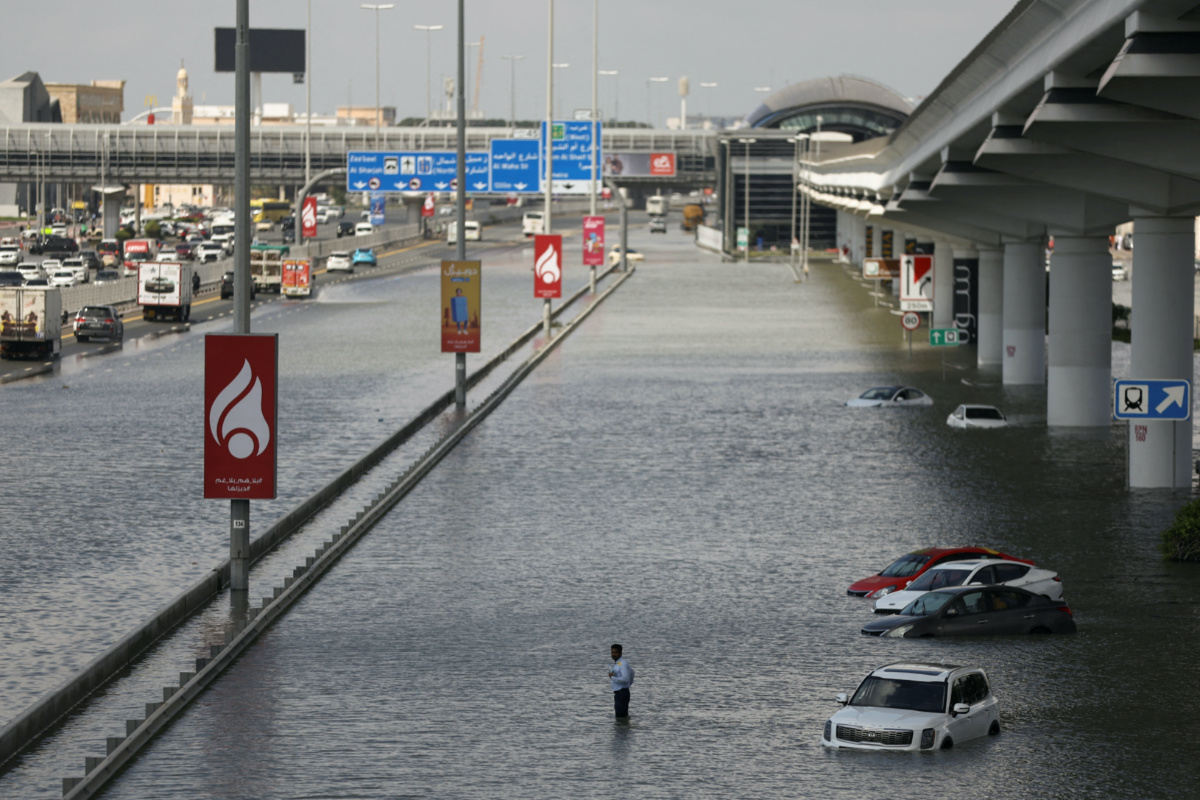Dubai, United Arab Emirates
Reuters
A storm hit the United Arab Emirates and Oman this week bringing record rainfall that flooded highways, inundated houses, grid-locked traffic and trapped people in their homes.
At least 20 people were reported to have died in the deluge in Oman while another person was said to have died in floods in the UAE that closed government offices and schools for days.

A general view of flood water caused by heavy rains, with the Burj Khalifa tower visible in the background, in Dubai, United Arab Emirates, on 17th April, 2024. PICTURE: Reuters/Amr Alfiky
The storm had initially hit Oman on Sunday before it pounded the UAE on Tuesday, knocking out power and causing huge disruptions to flights as runways were turned into rivers.
In the UAE, a record 254 millimetres of rainfall was recorded in Al Ain, a city bordering Oman. It was the largest ever in a 24-hour period since records started in 1949.
Cloud seeding cause the storm?
Rainfall is rare in the UAE and elsewhere on the Arabian Peninsula, that is typically known for its dry desert climate. Summer air temperatures can soar above 50 degrees Celsius.
But the UAE and Oman also lack drainage systems to cope with heavy rains and submerged roads are not uncommon during rainfall.
Following Tuesday’s events, questions were raised whether cloud seeding, a process that the UAE frequently conducts, could have caused the heavy rains.
Cloud seeding is a process in which chemicals are implanted into clouds to increase rainfall in an environment where water scarcity is a concern.
The UAE, located in one of the hottest and driest regions on earth, has been leading the effort to seed clouds and increase precipitation.
But the UAE’s meteorology agency told Reuters there were no such operations before the storm.
What about climate change?
The huge rainfall was instead likely due to a normal weather system that was exacerbated by climate change, experts say.
A low pressure system in the upper atmosphere, coupled with low pressure at the surface had acted like a pressure ‘squeeze’ on the air, according to Esraa Alnaqbi, a senior forecaster at the UAE government’s National Centre of Meteorology.
That squeeze, intensified by the contrast between warmer temperatures at ground level and colder temperatures higher up, created the conditions for the powerful thunderstorm, she said.

A person stands surrounded by flood water caused by heavy rains, in Dubai, United Arab Emirates, on 17th April, 2024. PICTURE: Reuters/Amr Alfiky
The “abnormal phenomenon” was not unexpected in April as when the season changes the pressure changes rapidly, she said, adding that climate change also likely contributed to the storm.
Climate scientists say that rising global temperatures, caused by human-led climate change, is leading to more extreme weather events around the world, including intense rainfall.
“Rainfall from thunderstorms, like the ones seen in UAE in recent days, sees a particular strong increase with warming. This is because convection, which is the strong updraft in thunderstorms, strengthens in a warmer world,” said Dim Coumou, a professor in climate extremes at Vrije Universiteit Amsterdam.
We rely on our readers to fund Sight's work - become a financial supporter today!
For more information, head to our Subscriber's page.
Can’t create clouds from nothing
Friederike Otto, a senior lecturer in climate science at Imperial College London, said rainfall was becoming much heavier around the world as the climate warms because a warmer atmosphere can hold more moisture. It was misleading to talk about cloud seeding as the cause of the heavy rainfall, she said.
“Cloud seeding can’t create clouds from nothing. It encourages water that is already in the sky to condense faster and drop water in certain places. So first, you need moisture. Without it, there’d be no clouds,” she said.
Global warming has resulted in “extraordinarily” warm water in the seas around Dubai, where there is also very warm air above, said Mark Howden, Director at the Australian National University’s Institute for Climate, Energy & Disaster Solutions.
“This increases both potential evaporation rates and the capacity of the atmosphere to hold that water, allowing bigger dumps of rainfall such as what we have just seen in Dubai.”
Gabi Hegerl, a climatologist at Edinburgh University, said that extreme rainfall, like in the UAE and Oman, was likely to get worse in many places due to the effects of climate change.
When conditions are perfect for really heavy rain, there’s more moisture in the air, so it rains harder. This extra moisture is because the air is warmer, which is because of human-caused climate change, she said.






